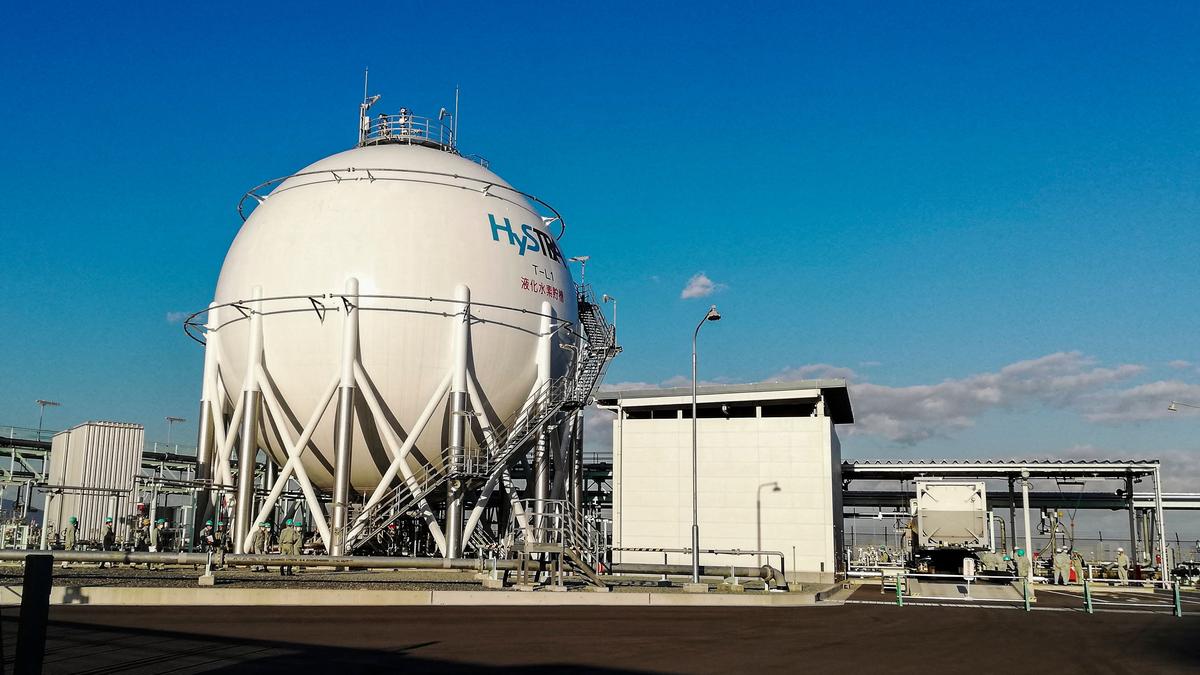Natural Hydrogen in India Unlocking Hydrogen Potential Introduction
- As India accelerates efforts to achieve its net-zero emissions target by 2070, the nation is exploring innovative and sustainable energy alternatives.
- One promising development is the identification of natural geological hydrogen—commonly referred to as white or gold hydrogen—which could revolutionize India’s energy mix by offering a clean, cost-efficient, and scalable solution to decarbonization.

What is Natural Hydrogen and Why It Matters?
- Unlike conventional hydrogen, which is produced through energy-intensive processes like steam methane reforming or electrolysis, natural hydrogen is formed through geological processes beneath the Earth’s surface.
- Tapping into these underground reserves could dramatically reduce the carbon footprint and costs associated with hydrogen production.
India’s Hydrogen Landscape: Current Demand and Future Needs
- Rising Demand for Hydrogen in India:
-
-
- India’s hydrogen consumption stood at around 6 million tonnes in 2020, driven largely by industries like oil refining and ammonia production.
- To meet its climate commitments and enable the transition to clean fuels, India’s hydrogen demand is expected to surge to 50 million tonnes per year by 2070.
-
- Potential Role of Natural Hydrogen:
-
- A recent academic study estimates India’s natural hydrogen reserves at approximately 3,475 million tonnes, indicating significant untapped potential.
- These reserves could substantially reduce dependence on traditional, energy-intensive hydrogen production methods, providing a more sustainable pathway to meet future demand.
Geological Insights: Early Evidence of Natural Hydrogen in India
- Promising Geological Findings:
-
-
- Initial signs of underground hydrogen reservoirs have been observed in the Andaman Islands, marking a pivotal discovery in India’s energy exploration efforts.
- Experts suggest that similar geological conditions exist across various parts of the Indian subcontinent, including cratonic and volcanic regions, which could host additional reserves.
-
- Theoretical Potential Still Needs Validation:
-
- While the 3,475 million tonnes figure is encouraging, it remains a theoretical estimate.
- Comprehensive and systematic geological surveys, drilling tests, and exploratory technologies are required to confirm these findings and assess commercial viability.
Why Natural Hydrogen Could Be a Game-Changer for India
- Low Environmental Impact: Natural hydrogen extraction could eliminate emissions associated with conventional hydrogen production.
- Cost Advantages: Avoids high electricity costs linked to electrolysis and infrastructure-heavy alternatives.
- Energy Security: Reduces reliance on fossil fuels and imported energy, aligning with Atmanirbhar Bharat (self-reliant India) goals.
- Strategic Reserves: Offers a stable, long-term domestic energy resource to power sectors like transport, heavy industry, and grid storage.
Understanding India’s Geological Potential for Natural Hydrogen
- Promising Geological Zones:
-
- Cratonic regions like the Dharwar and Singhbhum cratons
- Sedimentary basins including the Vindhyan and Gondwana formations
- Ophiolite belts in the Himalayas and Andaman Islands
- These areas exhibit essential features such as:
- Hydrogen-generating rocks rich in iron and ultramafic minerals
- Seals and subsurface traps capable of retaining hydrogen
- Geological structures conducive to large-scale gas accumulation
Need for a National Mapping Initiative
- India lacks a comprehensive understanding of its subsurface hydrogen landscape. To address this, the country needs a nationwide geological hydrogen mapping mission, akin to:
- AusLAMP (Australia)
- USArray (United States)
- Such initiatives can create 3D resistivity models of subsurface formations using magnetotelluric and petrophysical surveys.
Role of Public-Private Partnerships
- A collaborative model involving government bodies, private energy firms, and research institutions will be essential to implement large-scale exploration and data collection.
Overcoming Technological and Safety Barriers
- Key Challenges:
-
-
- Detection Complexity: Unlike oil or gas, hydrogen lacks mature detection techniques, making exploration unpredictable and resource-intensive.
- Difficult Extraction: Hydrogen’s small molecular structure and high diffusivity necessitate the development of specialized extraction infrastructure.
- Safety Concerns: Its flammability and reactivity demand robust safety measures in well design, storage, and transport.
-
- Innovation in Materials and Equipment: To ensure operational safety and longevity, the industry must:
-
-
- Utilize hydrogen-resistant coatings
- Modify cement additives for well casing
- Upgrade rubber linings and gaskets in transport systems
-
- Retrofitting Existing Infrastructure:
-
- Research is ongoing to adapt current natural gas pipelines and storage systems for hydrogen transport, reducing the need for entirely new infrastructure.
Global Innovation and India’s Strategic Opportunity
-
- Several countries, including the United States, are advancing beyond basic extraction toward innovative hydrogen generation techniques.
- Leading International Initiatives: ARPA-E (U.S.) is exploring:
-
-
- Inducing hydrogen production by injecting water into iron-rich rock formations
- Combining carbon capture with hydrogen extraction
- Designing intentional underground hydrogen reactors
-
- How India Can Leverage Its Strengths:
-
- Utilize existing oil and gas networks under the Directorate General of Hydrocarbons (DGH) to initiate hydrogen exploration.
- Analyze rock cores from previously drilled wells to identify hydrogen potential at minimal cost.
- Repurpose existing gas pipelines, with modifications, for hydrogen transport.
Commercializing Natural Hydrogen
-
- Key Enablers of Commercialization:
- Discovery of economically extractable reserves
- Affordable extraction technologies
- Clear regulatory policies to attract investors
- Government support via funding, tax incentives, and pilot projects
- Key Enablers of Commercialization:
- A Blueprint for Success: Learn from the National Solar Mission
- India’s National Solar Mission successfully boosted solar capacity through:
- Early investment in resource mapping
- Transparent public-private collaboration
- Targeted policy incentives
- A similar Natural Hydrogen Mapping Mission could serve as a foundational pillar to catalyze commercial interest and innovation.
Conclusion
- India is uniquely positioned to become a global leader in natural hydrogen exploration and utilization. With geological indicators pointing to vast reserves and global momentum building, the country stands on the brink of a new energy era. To seize this opportunity, India must:
- Undertake rigorous scientific exploration
- Develop technological solutions for detection, extraction, and transport
- Create a policy ecosystem that supports innovation and investment
- Ensure safety and sustainability across all operations
- Natural hydrogen could become the silent revolution that propels India toward a secure, indigenous, and decarbonized energy future.















